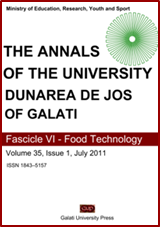Effect of maceration enzymes addition on the aromatic white winemaking
Abstract
White grapes of Muscat Ottonel variety were treated enzymatically with maceration enzyme preparation and then fermented with selected yeast. These treatments resulted in an increase of the extraction of the compounds involved in wine aroma and of the must yield. Also an improvement of filterability and a decreasing of the sedimentation and clarification time were noticed. The
enzymatic treatment presented a benefic effect on the dynamics of the alcoholic fermentation and the final wine composition. By using maceration enzymes, the wine aromatic intensity is emphasized, because the enzymatic preparation contains high concentrations of both glycosidase acting on the first stage of the enzymatic mechanism and the β-glucosidase acting on the second phase of enzyme mechanism able to release the aromatic constituents. These results are also closely related to the sensory analysis, which indicated that the glycosidase enzymatic treatment seemed to be effective for the improvement of the aroma of Muscat Ottonel wines.


